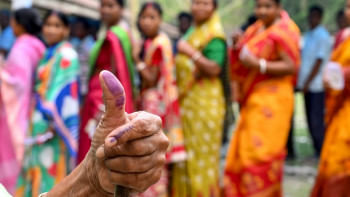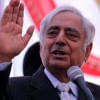Quest For 400: Modi banking on Ram Mandir hype, south surge

Prime Minister Narendra Modi-led Bharatiya Janata Party has set the bar high by coining the slogan "Ab ki baar, 400 paar", meaning the party-led National Democratic Alliance (NDA) is eyeing an unprecedented 400 of the total 543 seats and a 50 percent vote share in the Lok Sabha in the ongoing Indian national elections.
While Congress crossed the 400 seat mark in 1984 riding on a huge sympathy wave following the assassination of the then prime minister Indira Gandhi, the party stopped at 48.2 percent vote share. Four decades later, can BJP replicate that feat? Two important factors hold the key to BJP's push towards that.
One is the construction and consecration of the Ram temple in Ayodhya, which was held in January this year with much fanfare, giving rise to speculations that this would help BJP's main plank in Lok Sabha polls.
The Ram Mandir has been repeatedly used by BJP both in in the run-up to the Lok Sabha elections and the ongoing campaign. What seems to have given an edge to BJP is the opposition parties staying away from the temple consecration event in January despite invitation. More than once, Modi attacked the opposition Congress for not attending the event. The opposition refused to attend the event arguing it had been turned into a "political project" of BJP and that the consecration had been brought forward "for electoral gains".
Given the scale of the celebrations around the Ram temple inauguration by Modi and the hype created, there was little doubt that Ayodhya is set to be the centrepiece of BJP's electioneering. The temple is set to be a deciding factor for a large section of the electorate of the Hindu-majority country where the society has tilted rightwards even before Modi became prime minister in 2014. The construction of the temple and its consecration have helped the party further consolidate its status as the Hindu nationalist party. BJP feels Ram temple is the fulfilment of its ideological tenet that will galvanise voters across the length and breadth of the country and propel it to 400-plus seats and a 50% vote share.
The second component of BJP's "Ab ki baar, 400 paar" is its vigorous push to expand its footprints in the five southern Indian states along with the union territory of Puducherry which together account for 130 of the total 543 Lok Sabha seats. Influence in a major part of southern India has eluded BJP.
The party was unable to win any seat in Andhra Pradesh, Tamil Nadu and Kerala besides Puducherry in 2011. It had though swept Karnataka by winning 25 of its 28 seats and made impressive gains in Telangana by bagging for the first time four of its 17 seats. In its southward journey, the saffron party has built new alliances in Andhra Pradesh and Karnataka and won over a number of influential leaders from different parties in the region where BJP is in an overdrive to make impressive gains. The southern states, particularly Tamil Nadu, Kerala, Telangana, and Andhra Pradesh, have traditionally been the bastions of regional parties and Congress and Communists.
An important reason why BJP is desperate to win as many seats as possible in the south is that this may help the party seek a cushion for any fall in number in the states in the Hindi belt (Rajasthan, Madhya Pradesh, Bihar, Haryana, Uttarakhand, Himachal Pradesh and Chhattisgarh), west (Maharashtra) and the east (Bihar and West Bengal) where it had either made a clean sweep or major gains in the previous Lok Sabha polls in 2019.
In West Bengal, BJP is way behind ruling TMC in campaigning and its organisational presence and visibility in most parts of the state is much less compared to the ruling party. It is primarily banking on a potential undercurrent of resentment against alleged corruption and arrest of several TMC leaders. However, a slew of financial dole schemes by the Mamata Banerjee government may blunt the effects of corruption charges against the party leaders.
The question is can the Ram temple neutralise anti-incumbency against local BJP MPs as well as against the central government due to unemployment and price rise. BJP is also tapping into a weakened opposition INDIA alliance whose parties are fighting against each other in many of the states including West Bengal, Kerala, Andhra Pradesh, Telangana and Punjab. The opposition has also failed to implement its promise made last year to come out with a joint manifesto to take on BJP.

 For all latest news, follow The Daily Star's Google News channel.
For all latest news, follow The Daily Star's Google News channel. 









Comments